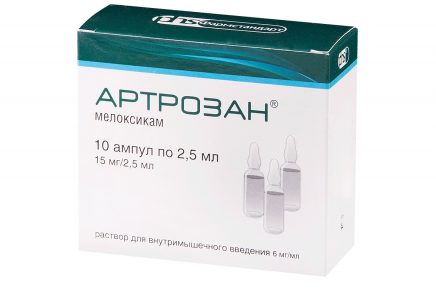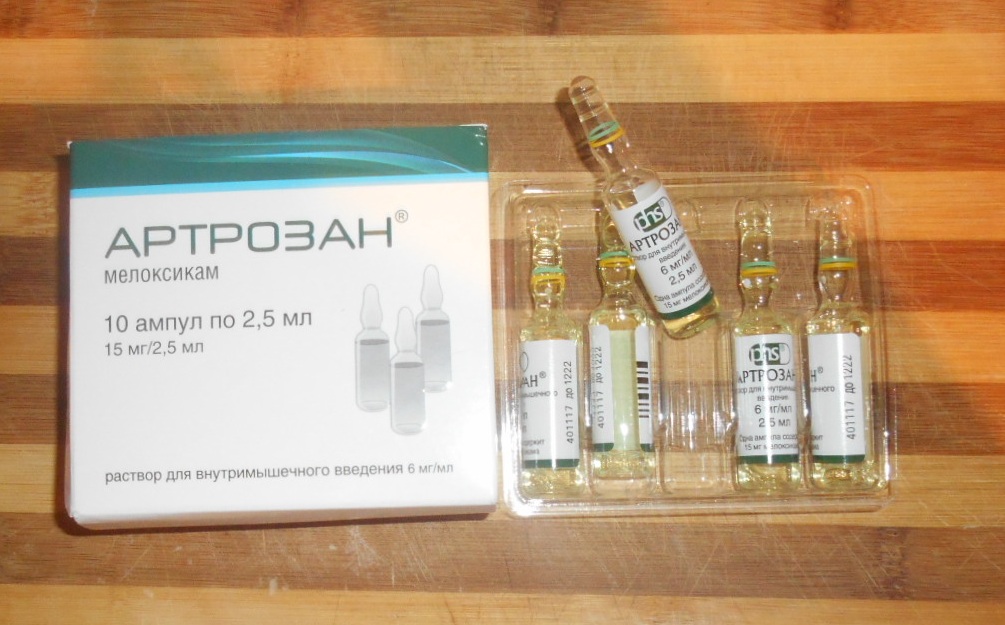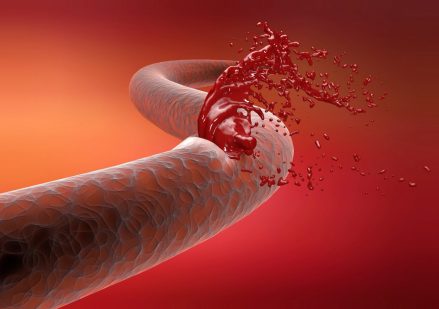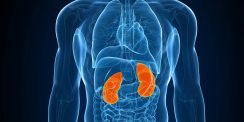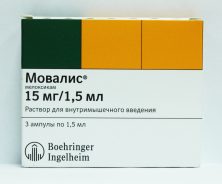Medicines from the group of NSAIDs (non-steroidal anti-inflammatory drugs) are, one might say, one of the most popular drugs for symptomatic treatment, that is, prostaglandins. This is due to the fact that NSAIDs have three directed actions on the body - painkillers, anti-inflammatory and antipyretic drugs. But at the same time, they do not have the side effects characteristic of other drugs with such an effect. In the article we will consider the features of Arthrosan, the instructions for the use of the drug and its properties.
Material Content:
- 1 Composition and form of release
- 2 Pharmacological properties and pharmacokinetics
- 3 What is the drug prescribed
- 4 Instructions for use and dosage of Arthrosan
- 5 During pregnancy and lactation
- 6 Drug interaction
- 7 Contraindications, side effects and overdose
- 8 Analogues of the drug in tablets and injections
Composition and form of release
In composition, Arthrosan is a monocomponent drug, the active substance of which is meloxicam. Excipients are different for different dosage forms, however, in tablets and in ampoules they are standard, as well as completely neutral to all processes in the body.
The list of release forms looks like this:
- Tablet form. The dosage of one tablet can be either 7.5 or 15 mg.
- Injection form (ampoules). Used for intramuscular injection and contains 6 mg of meloxicam per ml of solution.
- An external agent in the form of an ointment, gel or cream. The volume of one tube is 30 or 50 g.
Rectal suppositories, capsules and other forms are taken through the rectum. They can have several different dosages.
Pharmacological properties and pharmacokinetics
As mentioned above, the NSAID group has three different effects on the body - analgesic, antipyretic and anti-inflammatory. Unlike other groups of medicines with the same properties, NSAIDs do not have a large number of associated harmful effects, since the mechanism of action on the body of this group goes in a slightly different way.
All of them are divided into those with selective action and non-selective. The differences between these two types of NSAIDs are that non-selective agents block the enzymes cyclooxygenase-1 (COX-1) and cyclooxygenase-2 (COX-2) at the same time, and the selective type of NSAIDs is limited only by blocking cyclooxygenase-2. This is very important, since selective drugs have significantly fewer negative side effects. The thing is that when these enzymes are blocked, substances that cause pain and inflammation cease to flow into the body. However, COX-1, in addition, is responsible for maintaining the protective layer of the gastrointestinal tract. Accordingly, when it is blocked, protection is reduced and there is a risk of an inflammatory process in the stomach.
What is the drug prescribed
Indications are completely dependent on the mechanism of action of the drug. The main ones are:
- Pain syndrome and the diseases that accompany it. Arthrosan is recommended for joint diseases such as arthritis, arthrosis, osteoarthritis, osteochondrosis, radiculitis and inflammation of the ligaments. You can use both tablets and ampoule forms.
- Also, do not forget that NSAIDs are also used for other painful conditions, such as toothache or headache, as well as various neuralgia. In this case, Arthrosan tablets will be preferred.
- Ointments are most often used to relieve pain and inflammation in injuries, including sports. However, for diseases of the back, gels and ointments are also actively used and successfully help.
Arthrosan is not available in suppositories, but the active substance meloxicam may be part of other brand names of drugs. In this case, it is used primarily for hemorrhoids and similar problems.
Instructions for use and dosage of Arthrosan
In order to properly use the drug, you must first familiarize yourself with the instructions for use and clarify some of the nuances. First, you need to remember that any injections should be done only by a specialist who has all the necessary skills, while observing the conditions of sterility.
Arthrosan tablets
Dosage should be selected based on the duration and intensity of the pain. There are two total dosages: 7.5 mg and 15 mg. A tablet is taken with meals and washed down with water to prevent any possible side effects from the gastrointestinal tract and reduce possible harm. However, if the patient already has problems with the stomach, then it is impossible to assign him a higher dose of 7.5 mg. The maximum possible course of admission is from 5 to 7 days.
In ampoules for injections
The injection procedure itself is performed according to the standard algorithm: intramuscularly into the upper right square. The introduction of Arthrosan ampoules is done slowly in a 2.5 ml solution per application. Intramuscular injections should begin on average after 20 minutes. A day, you can use the drug 1-2 times. Despite the lower toxicity of the drug, the application should not be longer than 2-3 days. After that, if the pain persists, then you can change the injection drugs to tablets, which can be taken for up to 5 days.
Remember that if any problems of an allergic nature are manifested, then the drug should be stopped immediately and consult a doctor for adjusting the therapeutic regimen.
During pregnancy and lactation
The use of meloxicam during pregnancy and lactation is strictly prohibited.This is due to the fact that the drug can seriously harm the health of both the expectant mother and her baby. Due to the action of NSAIDs on the kidneys and liver, this can lead to a variety of problems, including fluid retention in the body and metabolic disorders.
During lactation, meloxicam should also be excluded, since it is excreted in breast milk and can enter the body of a newborn with it, whose protective barriers have not yet been fully formed. Exposure to meloxicam can provoke inflammation and harm the child. If taking painkillers of this group is necessary, breast-feeding should be stopped at least a few days before the start of treatment.
The need to take these drugs in the expectation of a baby or breastfeeding can only be determined by the attending physician. You should not self-medicate, even using drugs such as NSAIDs that are popular among many people.
Drug interaction
The combination of Arthrosan with other drugs is subject to a lot of restrictions. All of them are described in detail in the instructions printed on the leaflet.
Key interactions to be aware of:
- You can not combine Arthrosan with other painkillers from the NSAID group. This can lead not only to the formation of an inflammatory process in the stomach and intestines, but also contribute to the formation of ulcers in the mucous membrane.
- Arthrosis reduces the effectiveness of drugs that lower blood pressure.
- Methotrexate in combination with Arthrosan may contribute to a greater effect on the hematopoietic system, and in especially severe cases leads to anemia. Particular attention should be paid to this, since the combination of these two drugs in one treatment regimen can occur quite often.
- There is a risk of reduced effectiveness of oral contraceptives, which should be addressed to girls who are undergoing treatment with arthrosan or meloxicam.
- Side effects in the form of bleeding can be enhanced if anticoagulants are used simultaneously with Arthrosan.
As you can see from the list, Arthrosan, like all other NSAIDs, is not at all an absolutely harmless pill from everything. In addition to negative phenomena due to the combination of the drug with other medications, there are a fairly large number of usual side effects and contraindications, which you also need to know about.
Contraindications, side effects and overdose
Contraindications for Arthrosan are associated primarily with a negative effect on the digestive tract, but there are some others:
- Hypersensitivity and allergies.
- Risk of bleeding, especially internal. This item also includes bleeding caused by the possible formation of stomach ulcers.
- Diseases of the kidneys and liver, especially kidney and liver failure. During an exacerbation, taking Arthrosan is categorically contraindicated, while in the chronic stage, you can use the drug Arthrosan, but with great care.
- Pregnancy and childhood.
Despite the selectivity, it does provoke some weakening of the protective functions of the digestive tract, although to a much lesser extent. Therefore, even in the absence of the above, pain relief with NSAIDs should not be abused.
Of the adverse reactions, first of all, dyspeptic disorders can be distinguished: heartburn, nausea or problems with stool. If severe pain appears in the stomach or intestines, you must stop the course and consult a doctor. Also, Arthrosan can cause allergic reactions and contribute to the appearance of bronchospasm.
Some patients report the appearance of edema, including lower limbs. Others indicate dizziness or vision problems. But these side effects are extremely rare and unlikely.
An overdose is also most associated with the gastrointestinal tract, but in addition, visual and hearing impairment, severe dizziness and anaphylactic shock (in rare cases) can also occur. If such a situation arises, you need to call an ambulance and rinse the affected stomach to remove undissolved drug residues.
As a rule, an overdose situation occurs either in the case of accidentally taking a second pill, or with independent attempts to relieve pain. That is why it is highly recommended not to deviate in any way from the treatment regimen established by the doctor.
Analogues of the drug in tablets and injections
Meloxicam is extremely popular as an anesthetic, so Arthrosan has a lot of complete analogues in composition. This list includes Movalis, Remelox, Amelotex, Movasin, Meloxicam-Maxfarma, Melbek and many others. Most of these drugs are available in tablets, but Movalis and Melbek are also produced in ampoule form.
On the market there are analogues of Arthrosan containing other active ingredients: Diclofenac, Ketoprofen, Nimesulide. But a complete replacement in this case is not possible, since they belong to non-selective COX inhibitors and may be contraindicated to the patient.
But even if the replacement is made with a full analogue of Arthrosan, you still need to carefully study the instructions for use, consult your doctor and study all possible differences that really vary from manufacturer to manufacturer. This is due to the fact that not only the substance purchased for the production of the drug, but also the technology is changing. Therefore, any replacement of one drug with another should be previously authorized by a doctor, and if a specific generic is suitable for a particular patient, then it is advisable to give preference to him.
Therefore, always follow the history, be sure to listen to the advice of a doctor. Analogues of the drug are effective, and you need to approach substitutes with caution. Be healthy.




